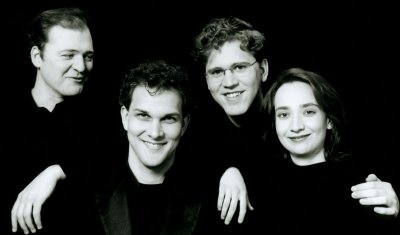
Cuarteto Casals, photo by Jo Schwartz |
When the
Cuarteto Casals came to the Library of Congress
last year at about this time, we were not able to review their concert. However, we heard enough good reports of their playing that we were not going to make the same mistake this year. In their concert Saturday night at Dumbarton Oaks, on the
Friends of Music series, the talented, young Spanish string quartet joined with oboist Thomas Gallant in an exceptional program of 18th- and 19th-century music. First, an oboe quartet by Josef Fiala (1748-1816) was an exotic
amuse-gueule meant to wake up the palate. The composer was an oboist in the Salzburg court orchestra and a close friend of the Mozart family, and the piece is mostly for the oboe, essentially replacing first violin in a string quartet formation (Vera Martínez Mehner played the lone violin part), to show off on lots of runs. With sensitive playing and nice touches added on the repeats, this was a gracious first course, especially the melancholy Andante third movement, not least because it was such a rarety.
A twin course of better-known Classical music served as substantial antipasti, beginning with the entire Casals Quartet on Haydn's C major quartet (op. 54, no. 2). This quartet is a sunny, folk-inflected work with the composer's typical jollity subsumed more subtly than in some of his other quartets. For example, in the light-hearted sonata-allegro form first movement, the first violin humorously tacks an extra little triadic iteration on to the first theme at the recapitulation, handled with grace by Abel Tomàs Realp, who sat first violin for this quartet. Tomàs Realp also brought a ruddy Gypsy quality to the Hungarian variations in the spicy slow movement. The fourth movement, uncharacteristically serious for Haydn, included exhilarating sparkle in the Presto section and soaring line in the Adagio sections.
Gallant then returned with his oboe for the Mozart oboe quartet in F major (K. 370, from 1781). Written for the Mannheim oboe virtuoso Friedrich Ramm, while Mozart was in Munich working on
Idomeneo, it is a daring work. Thomas Gallant has collaborated with many well-regarded chamber groups, including the Kronos, Lark, Calder, and Colorado String Quartets, and it is easy to see why. Gallant's striking technique, combined with careful shaping of lyrical lines, was impressive and even more so on this most difficult piece. The soft, purely intoned high F (the one way off the staff) that concludes the final movement was as pretty as such a note could be on the oboe, and the extremely virtuosic runs, even when they broke into ultra-rapid triplets, were flexible and accurate.
As charming as the pieces in collaboration with Gallant were, the two works featuring the Cuarteto Casals alone were a shade more pleasing, because the four players work together so cooperatively. This was most true of the devastating main course, Schubert's final string quartet (G major, D. 887), which as American-born violist
Jonathan Brown mentioned in his introduction, featured prominently in Woody Allen's
Crimes and Misdemeanors. The group's performance of its first movement, a counterpoint of light and darkness, was so emotionally powerful that a woman in the audience exclaimed when it was over, "Such music..." (in a whisper audible enough for the players to turn briefly to look at her). One has the feeling that Schubert's music would come across that way even if the performance were merely good, but this was several steps above. The Schubert was the high point of the concert (Brahms and Arriaga had been announced), even if the first half of the fourth movement, played very fast, never quite notched itself into place as it should have. All in all, this was another superb concert at Dumbarton Oaks, where chamber music is played as it was intended, with a small audience elbow to elbow with excellent performers.
The Cuarteto Casals will play later this month -- parts of this program plus the first Ligeti quartet -- at Carnegie Hall (February 23). The remaining concerts on the Friends of Music subscription series at Dumbarton Oaks this season will feature the Katona Twins (March 2 to 4), two guitar-playing brothers from Hungary, and the French ensemble La Fenice with Jean Tubéry and Spanish soprano Arianna Savall (April 20 to 22). To subscribe to the series, contact Cindy Greene by phone (202-339-6436) or e-mail (GreeneC at doaks dot org). Ionarts is hoping to catch the second one especially.

No comments:
Post a Comment